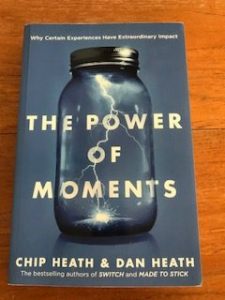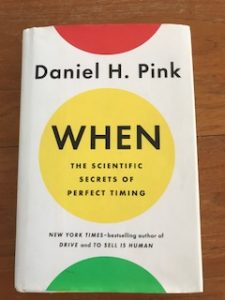‘When’ Matters
August 20, 2018 - 7 minutes readWhen I think back on the summer, a few moments stand out for me. One was finishing a challenging 300 km cycle around the Cabot Trail on Cape Breton Island that included several daunting mountain climbs (well, that’s my perspective of course). Not only did it provide a sense of accomplishment for me especially as I hadn’t exactly ‘trained’, but it was an opportunity to launch the summer break in a memorable way.
My summer reading consisted of the The Power of Moments by Chip Heath and Dan Heath, and Daniel Pink’s When: The Scientific Secrets of Perfect Timing. I didn’t intentionally choose books that focused on the element of time, yet both reads certainly had commonalities and offered up ideas that I could apply to my role as a school leader. I tend to think more about the ‘what’ in my practice and not necessarily the ‘when’. After reading both books, I learned that ‘when’ should be an important consideration when making decisions related to student well-being and learning. 
 In my many years of being an educator, the start of a new school year is accompanied by a sense of excitement, anticipation and a few jitters. It marks a new beginning. As Daniel Pink notes, “…beginnings have a far greater impact than most of us understand. Beginnings, in fact, can matter to the end.” He goes on to write, “…we should be awake to the power of beginnings and aim to make a strong start.” Pink suggests that many days are particularly effective for making a fresh start, one of them being the first day of school.
In my many years of being an educator, the start of a new school year is accompanied by a sense of excitement, anticipation and a few jitters. It marks a new beginning. As Daniel Pink notes, “…beginnings have a far greater impact than most of us understand. Beginnings, in fact, can matter to the end.” He goes on to write, “…we should be awake to the power of beginnings and aim to make a strong start.” Pink suggests that many days are particularly effective for making a fresh start, one of them being the first day of school. 
Chip and Daniel Heath also write about the first day of school being a moment of “…elevation and connection and pride…”. The first day of school is an example of a potential moment that “cries out to be shaped”. Schools have the opportunity to shape this day and be the designers of a moment that matters, one that is meaningful and memorable.
On September 4th, Grade 8 students are transitioning to a brand new school environment and beginning their five-year journey through high school. This is a significant temporal landmark. To make it a memorable day, Rockridge staff has planned activities to “spark insight”, and “boost the sense of connection” (Heath & Heath).
– Students will be welcomed by upbeat piano tunes being played by our accomplished student musicians
– Grade 8 students will be greeted by Grade 9 and 10 mentors and guided to their homeroom
– Students will engage in fun getting-to-know-you activities
– Timetables and locker combinations will be distributed
– Under the guidance of mentors, students will locate their assigned locker and practise opening their locks
– Mentors will tour the school with students, introducing them to our custodian, their teachers, administrators, counsellors, youth worker and office staff
– Students will end their shortened day by returning to homeroom for a snack before heading home
Our aim is to ensure our Grade 8 students go home feeling excited to return the next day, armed with the knowledge they need to make them feel comfortable in their new surroundings. This day should be a defining moment for them.
In addition to the importance of ‘beginnings’, Daniel Pink also writes about the significance of ‘breaks’. The importance of providing breaks for students has been a topic of conversation in our schools for many years. As we deepen our understanding of self-regulation, we have learned that frequent breaks help students sustain focus. In elementary school, they are called ‘body breaks’ or ‘action breaks’. At the high school level, students are given ‘brain breaks’, as teachers recognize that cognitive fatigue can set in at some point during an 80-minute instructional block. 
Pink brings up some interesting points about the timing of breaks. He references research done in Denmark on results of national standardized exams. Danish students who wrote their tests in the morning scored significantly higher than those who wrote in the afternoon. This isn’t particularly surprising; however, what is interesting is that when the students had a break for twenty to thirty minutes to eat, play and socialize before taking the tests, their scores did not decline in the afternoon. In fact, their scores were higher after having a break regardless of the time of day.
Pink also offered advice on what breaks should look like. According to his research, five guiding principles can be applied for all organizations, including schools:
Something beats nothing. Evidence indicates that short, frequent breaks are effective.
Moving beats stationary. One study showed that “hourly five-minute walking breaks boosted energy levels, sharpened focus, and improved mood throughout the day and reduced feelings of fatigue in the late afternoon.”
Social beats solo. “Much of the research on restorative breaks points toward the greater power of being with others…”.
Outside beats inside. “Taking a few minutes to be in nature is better than spending those minutes in a building.”
Fully detached beats semidetached. When taking a break, try not to combine it with another cognitively demanding activity.
In the year ahead we will strive to make ‘when’ a priority when structuring breaks into the day for students, not only for their well-being, but to potentially boost their productivity and levels of achievement. We will also aim to create defining moments for our students, ones that shape their lives and endure in their memories. Surely the first day of school and graduation are defining moments, yet many moments in between deserve to be highlighted as well and could serve as opportunities to foster a sense of pride and connection. With a little planning and a lot of enthusiasm, perhaps we can make ordinary moments become extraordinary ones for our students. ‘When’ matters.

Recent Comments